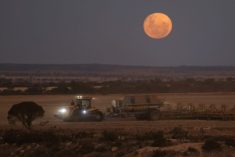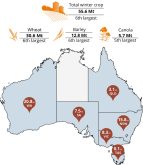Sydney | Reuters –– Australia faces a rise in temperature of potentially more than 5 C by the end of the century, outpacing global warming worldwide, the country’s national science agency said Tuesday.
In its most comprehensive analysis yet of the impacts of climate change, the Commonwealth Scientific and Industrial Research Organization (CSIRO) painted a worst-case scenario of a rise of up to 5.1 C by 2090 if there are no actions taken to cut greenhouse emissions.
“There is a very high confidence that hot days will become more frequent and hotter,” CSIRO principal research scientist Kevin Hennessy said. “We also have very high confidence that sea levels will rise, oceans will become more acidic, and snow depths will decline.”
Read Also

Brazil to reap record soy crop in 2025/2026, increase exports
Brazil’s Conab said the country will reap a record soybean crop of 177.6 million tons in the 2025/2026 harvest year, according to data released on Thursday.
The dire warning from the government-funded agency is at odds with the official line from Australian Prime Minister Tony Abbott, who in 2009 declared the science of climate change was “crap.”
Abbott last year scrapped a tax on carbon pricing and abolished the independent Climate Commission, saying recent severe droughts that have crippled cattle farmers were “not a new thing in Australia.”
As the host of the Group of 20 last year, he attempted to keep climate change off the agenda, resulting in an embarrassing backdown at the Leaders Summit in Brisbane after U.S. President Barack Obama used a high-profile speech to warn Australia that its own Great Barrier Reef was in danger.
One of the world’s biggest carbon emitters per capita, Australia initially declined to join the U.S., Japan, France and others in contributing to the United Nations’ Green Climate Fund.
At the Lima climate change conference in December, Australia announced it would provide A$200 million from its existing aid budget — a method of contributing that went against agreements when the fund was set up at the Copenhagen conference in 2009.
Abbott has committed A$2.55 billion (C$2.51 billion) to a domestic initiative to reduce Australian’s emissions by five per cent below 2000 levels by 2020.
The new research by CSIRO and the Bureau of Meteorology, using some 40 global climate models, has Australia warming at a greater rate than the rest of the world.
The 5.1 C projection for 2090 is at the top end of a range starting at 2.8 C and is dependent on how deeply, if at all, greenhouse gas emissions are cut. The world average is for an increase of between 2.6 and 4.8 C.
The report said the annual average temperature in Australia would likely be up to 1.3 C warmer in 2030 than the average experienced between 1986 and 2005.
— Jane Wardell reports for Reuters from Sydney.













